|
In 1997, Joseph Riva, senior geologist writing for the Colorado
School of Mines, turned a skeptical eye toward the rapidly
emerging dependence of the United States on natural gas (NG). Riva
suggested that the rush to embrace NG as the primary fuel to meet
incremental electricity and space heating demand was based more on
sociopolitical hope than on geological reality. Noting that
domestic NG production had peaked at 22.6 tcf in 1973, Riva
questioned not merely whether the EIA projected production of 25.5
tcf by 2015 could be met but even whether the then current output
of 19.8 tcf could be maintained. Basing his analysis on the level
of known reserves and the rate of new discoveries, Riva argued
that unless an unprecedented number of large fields were found
soon:
“by early next century, natural gas will have become more of an
energy problem than an energy solution”.
Subsequent events have provided ample support for Riva’s grim
assessment: (1) domestic NG production only reached 19.7 tcf in
2004 despite an additional 461 rigs in the field—an 82 % increase
over 1997; (2) NG well head prices have steadily escalated from
$2.10 mcf in 1998 to $ 6.31 mcf in the first four months of 2005 –
an increase of $ 4.21 ( 200 %); and (3) chief U.S. policy makers
(e.g., Alan Greenspan) now readily admit the nation cannot meet
its NG supply needs and will be increasingly reliant on imports
from politically unstable areas – darkly paralleling our current
dependence on foreign areas and the entailing socioeconomic costs.
In essence, Riva’s foretelling is coming to pass. The present
paper takes his concerns as a point of departure to delineate a
range of reasons as to how unless the United States begins to take
the NG supply / demand situation more seriously, NG is likely to
move from the role of energy boon to national liability.
THE SPECTER OF DEMAND SHOCK
Given the status of NG as the cleanest of the fossil fuels, a
confluence of environmental regulations, efficiency of combustion
and simple convenience has led to an unprecedented build-out of
the NG demand infrastructure – particularly through massive
construction programs for power plants and new single family
homes. Yet, despite this increased dependence on NG to supply
electricity and heat our buildings, the casual observer of
business news would be hard pressed to find a systematic
discussion of the commodity. The price of oil has its own ticker
on television business networks but NG may or may not be mentioned
in a given day. As a result of this benign neglect there is only
dawning recognition that a shortfall of NG may soon reverberate
throughout the socioeconomic system – harkening back to the 1970’s
with the closing of schools and businesses in the dead of winter,
reducing manufacturing production and leaving millions of
homeowners wondering how they are going to pay their heating bill.
The stunning realization of the NG problem, however, is only a
sustained heat wave, hurricane, frigid January, coal strike or
nuclear shut-down away. And when that day comes the U.S. will come
face to face with a series of NG demand issues looming ever larger
on the horizon:
(1) Construction of NG heated homes – throughout the
1970’s and 80’s electricity was the preferred space heating source
for newly constructed single family homes. In 1979, for example,
51% of new homes were heated with electricity as opposed to only
39% with NG. Over the past decade, however, NG has clearly become
the fuel of choice in 70% of new homes with electricity dropping
to 27%. In fact, over the period 2001-2004 over 3.3 million new
homes heating with NG have come on line – over 70,000 per month.
Further, the construction of new homes is hardly slowing as the
most recent housing data indicate that single family homes heating
with NG are growing at an annualized rate of over 1.1 million.
Finally, these homes are being constructed in regions with harsher
winters .The latest American Gas Association data indicate 92% of
new homes in the Midwest heat with NG as opposed to only 48% in
the South.
(2) Construction of NG fired power plants. The NG
shortages of the 1970’s prompted the passage of the 1978 Fuel Use
Act (FUA) effectively banning NG fired electric power plants as
well as the use of NG in large industrial boilers. These
restrictions on NG consumption led to a substantial decline in
demand and the eventual formation of a supply “bubble” – which in
turn resulted in chronically low NG prices (See EIA, 2005). In
1987 much of the FUA was repealed setting off a surge in the
construction of NG power plants. Indeed, NG consumption for
electric generation rose from 2,636 bcf in 1988 to 5,352 bcf in
2004 (a 103 % increase). In fact, since the 1990s virtually all
new power plants have been NG units in an historic departure from
the traditional fuel diversification strategy of electric
utilities:
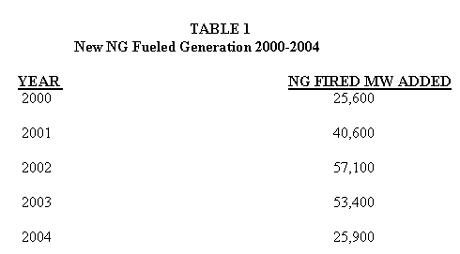
In essence, in just five years we have added over 200,000 MW of
NG facilities to the electric power system in the United States –
the functional equivalent of 245 Calvert Cliffs Nuclear Units (825
MWe). And the NG beat goes on – in April, Florida Power and Light
announced the addition of a new 1,100 MW combined cycle plant at
Manatee; in May, Calpine placed a 500 MW unit in operation at
Pastoria in California and this summer, utilities in Wisconsin
will add almost 1,300 NG fired MW to the grid. Finally, and
somewhat amazingly, the EIA projects that over the period 2005 –
2007 we will build an additional 83,000 MW of power stations – of
which 73,000 (88%) will be NG fueled.
(3) Organic Demand Growth
The population of the United States increases by one person
every 12 seconds – or 2.6 million per year. In April of 2005 there
were about 650 thousand homes under construction which will heat
with NG. Thousands of MWs of new NG fired turbines are being
constructed or are in the planning stage. The OMB projects the
economy of the United States will grow by over three percent each
of the next five years. Each year thousands of cars, trucks and
busses join the NG fleet. Stores, swimming pools, apartments,
agricultural buildings and many other NG dependent facilities are
constructed throughout the Country every single day.
The EIA has projected NG consumption growth along these lines:
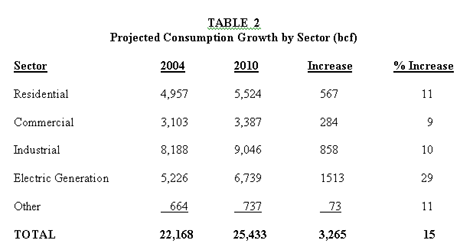
This relentless pressure from natural increase provides a
chronic dynamic of demand growth complementing the potential acute
demand from weather or alternative fuel problems.
(4) Supply constraints on other fuels for electricity
The United States is the most electric intensive nation in the
world. Demand for electricity has steadily increased over the past
half century and that growth has accelerated over the last 15
years. In 1991, for example, the U.S consumed about 2,762 billion
kilowatt hours (kwh) of electricity. By 2004 demand reached 3,550
billion or an increase of 29%. Coal provided half of this
electricity, nuclear 20% and NG 17 %.
Further, the demand for electricity is projected to increase
steadily for the foreseeable future. The EIA has projected that
2005-2006 will see a demand increase of 189 billion kwh. To put
the magnitude of this bi-annual increase in perspective, an 825
MWe nuclear power plant such as Calvert Cliffs 1 generates about
7.5 billion kwh in a year – or about 4 % of what must be added in
2005/2006 alone – thus, necessitating the construction of the
equivalent of over 25 such nuclear power plants (compared to an
existing nuclear fleet of 103).
Virtually all of the recent growth in electricity demand , as
well as forecasted growth , has been, and must be, met by NG. The
construction of NG power plants dominates the electric power
situation in the United States.
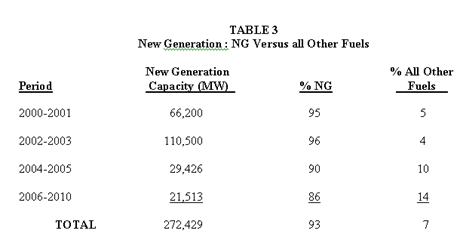
In essence then, for the entire decade, new capacity for coal,
nuclear, hydro and all other fuels combined will have provided
only seven percent of all new power plants – dramatically
highlighting the Nation’s increasing dependence upon NG. Further,
each of these alternative fuels has sufficient problems to
question whether they can meet even that meager expectation.
Coal provides about half of our electricity but is faced with
(a) stringent environmental regulations, (b) transportation
constraints and (c) questions about expanded production. The EIA,
for example, has projected that coal production would expand 53
million short tons in 2005 versus 2004 – an increase of 4.7%. Year
to date output, however, reveals that production in 2005 has
actually decreased sequentially by 489,000 short tons or 0.1%.
In terms of nuclear power, the 103 existing stations are
already operating near maximum capacity (94%) despite their aging
status (most over 25 years). The lead time to build a nuclear
plant would take us well into the next decade. And in regard to
hydroelectric, drought conditions in the western U.S. make each
year a touch and go situation. This year, for example, the
snowpack melt peaked in late May and rivers in Washington are
currently running below normal. Further, not only is there
environmental opposition to new hydro facilities but even the
relicensing of existing units faces intense scrutiny. Finally, as
of this writing, oil is over $60 per barrel. Clearly, the degrees
of freedom for fuel switching away from NG to meet incremental ,
indeed, even existing , electricity demand are quite limited.
THE EMERGING SHORTFALL OF NG SUPPLY
In 2004 the United States consumed 22,424 bcf of NG – virtually
all of which came from one of three sources – (1) domestic
production [82%], (2) imports from Canada [15%], and (3) imported
LNG [3%]. Further, the EIA has projected steady demand increase
with consumption rising to 25,433 bcf in 2010 and 29,952 in 2020.
Given the increasing demand for NG, continued – and expanded –
supply from the three primary sources delineated above is
essential to meet growing demand.
Unfortunately, significant and alarming problems with each of
these sources threaten to substantially curtail supply and thereby
contribute an emerging shortfall of NG. Consider, for instance, in
2004 only three regions accounted for 58% of the U.S. NG supplies
– the Federal Gulf of Mexico (18%), Texas (24%), and Canada (16%).
(1) Declining Production in the Gulf of Mexico
In 2000 the Federal Gulf of Mexico (GOM) accounted for 24 % of
NG production in the United States. Depletion and the exodus of
major oil companies, however, have taken a toll:
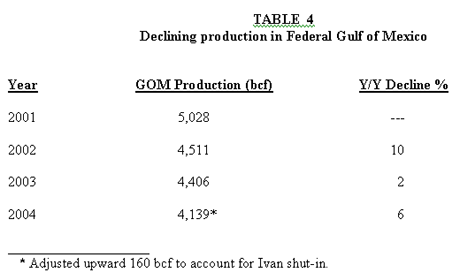
As these data indicate, production in the GOM declined steadily
over 2001-2004 by 889 bcf or 18 % and by 2004 the GOM accounted
for only 20% of U.S. production. Further, data from January, 2005
indicate this decline is continuing as a further 17 bcf (5%) Ivan
adjusted drop occurred relative to January, 2004. And, given the
recent drilling patterns in the GOM, it is likely this decline
will continue. In 2001 there were 153 rigs drilling in the GOM, by
2003 that number had decreased to 108 – and last week it had
slipped to 95.
(2) Stagnation in Texas
Texas has been a mainstay of NG production in the United States
and in 2004 accounted for 27% of output. But there are real
indications that the relentless nature of depletion is beginning
to take a toll on Texas production. Indeed, Dietert and his
associates (2005) have argued that important NG fields in Texas
are susceptible to significant decline rates. While EOG has pegged
the overall first year decline rate for new wells at 30% , 2005
Dietert et al have argued that decline rates for particular fields
--- Barnett Shale, Bossier Trend and South Texas are now in the
65-75% range. Actual production data from Texas starkly indicate
the treadmill facing the NG industry:
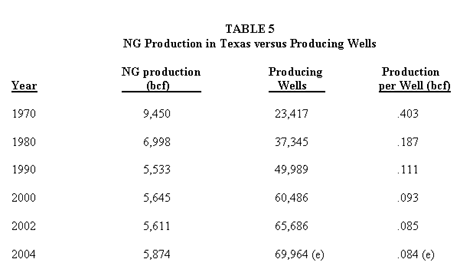
In other words, it took three times as many wells in 2004 to
produce 62% of the NG produced in Texas in 1970. These data give
real meaning to the oft repeated maxims “treadmill” and “the
lowest fruit has already been picked”. And the downtrend
continues, preliminary data from the Texas Railroad Commission
indicate that 71,440 wells as of February, 2005 could not stem a
production decline of over 12% versus February, 2004.
(3) Canada has its own NG Problems
In a 2003 article I argued that Canada would be unlikely to
alleviate NG supply problems in the United States. Specifically,
Canada faces many of the same supply issues which plague the U.S.
– namely – depletion. In terms of depletion, First Energy (2004)
has estimated annual decline rates for western Canadian NG fields
:
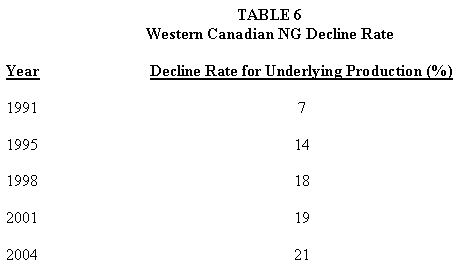
Actual production data provide strong evidence of these decline
dates. In 2002, there were 9,061 NG wells drilled in Canada and
production was 17.4 bcf/d. In 2004, there were 16,000 wells
drilled and production was still 17.4 bcf/day. In other words, an
increase of 6,939 (77%) wells from 2002 to 2004 was only able to
keep production flat. The shocking implications of this pattern
are obvious.
This situation is especially disturbing since Canada has been
the overwhelming source of NG imports to the U.S. In 1993, for
example, Canada accounted for 86% of U.S NG imports and by 2003
that figure was 87%. The Canadian safety net has been crucial as
our own NG production declined and demand ramped up.
Unfortunately, based on EIA forecasts the days of increasing NG
imports from Canada appear to be over:
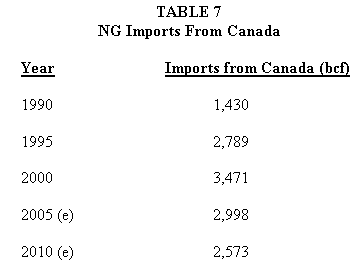
In essence, the rise in Canadian imports in the 90s appears to
have peaked and declining imports are projected with a decline of
898 bcf (26%) from 2000 to 2010.
(4) Drilling and Service at Full Utilization
In 1980, 3970 rigs were drilling for oil and NG in the United
States. As the industry fell on hard times in the next two decades
the number of active rigs steadily declined to reach a nadir of
only 625 in 1999 – a decline of 3,345 ( 84 %) rigs in less than 20
years. Idle rigs were sold at pennies on the dollar, left in the
field to rust or cannibalized for parts. The rig construction
industry came to a virtual standstill as less than ten rigs were
built per year. The rig service industry experienced a
corresponding decline as workover and service companies simply
went out of business or were merged with larger competitors. And
finally, the workforce in the oilpatch steadily aged as few young
people were willing to risk a career on what many considered a
moribund industry.
This chronic underinvestment in our energy supply
infrastructure is coming home to roost. Andrew Gould, CEO of
Schlumberger, succinctly summarized the situation in the keynote
presentation at the Howard Weil Energy Conference in April:
“the industry is dealing with … the lack of investment over the
past 18 years … A lot of the rig fleet, and much of the equipment
are old. Very little spare capacity exists … [but] the most
disturbing shortage by far is the lack of [energy] professionals …
skilled people have either been laid off, or have retired from the
industry.”
Recent data place Gould’s concerns in bold relief. The U.S. rig
count has surged to over 1,358 out of an estimated 1,470 capable
rigs. When rig float (units being moved from one site to another)
is considered there are apparently only several dozen capable rigs
not working.
In fact, Richard Mason at Land Rig Newsletter has indicated the
panic to get a rig has propelled huge increases in dayrates
because land drillers are “out of rigs for all practical
purposes”. Further, Mason notes that even the most optimistic
estimates indicate less than 100 newbuilds or refurbishments would
be available before 2007 – compared to 325 added from inventory in
2003-2004 alone.
The situation in the GOM is even more alarming --- the rig
market is so tight that dayrates have leaped from $24,000 in 2003
to $62,000 or more. Attrition of older rigs and years of
outmigration from the GOM have left the region with only a
fraction of once available rigs.
Further, the GOM faces the specter of even further outmigration
as national oil companies and operators in the Middle East, Far
East and North Sea are willing to pay as much as $140,000 per day
for a premium rig. And, to add insult to injury, although there
are over 30 news builds on order, it appears that none will be
available for the GOM. Given a world-wide bidding war, Daniel
McNeese at Rowan summed up the risk to GOM production: “rigs are going to get pulled out of here if rates don’t go up
… I mean people are bidding all over the world”.
Equipment and tubular manufactures such as National Oilwell
Varco (NOV) and Maverick Tube (MVK) are hard pressed to meet
demand and face record backlogs. Thomas Richards at Grey Wolf
Drilling recently complained that even simple rig components were
taking six months on order and another drilling firm stated that
NOV should “double the size of their company”. Clearly, the age of
the fleet (most rigs are over 25 years old) means that continual
refurbishment is exacerbating the already intense pressure on rig
suppliers.
And finally, the shortage of experienced personnel haunts the
industry at every turn. Guardis Banister, Technical Director at
Shell Energy has anecdotally commented that “while the U.S.
produces 43,000 lawyers per year we graduate only 430 petroleum
engineers.” Further, there are simply not enough oil field hands
to meet demand, setting off intense competition for skilled
workers. In a recent article, Richard Mason offered the following
anecdote:
“Contractors are now beginning to cannibalize the existing
labor force. A help wanted advertisement in our local Sunday
newspaper was run by an Oklahoma City contractor who is moving
refurbished rigs to West Texas. The Company was looking for
toolpushers … a bonus, was available if toolpushers could bring
crews along.”
Finally, the lack of new blood in the industry is becoming
extremely apparent. Panelists at an Offshore Technology Conference
session in May warned that the average age of personnel in the
upstream sector is 49.
Restricted Access to Major NG Fields
Environmental and political opposition to drilling new areas
greatly constrains potential NG production. Despite our haste to
build a huge NG demand infrastructure we do not have the
commitment to increase supply. There is a hypocrisy in place here.
Recently, Representative Lois Capps (D-CA) expressed her: “strong support for the long standing bipartisan legislative
moratorium on new leasing activity … despite efforts by … the
natural gas industry to open up the Outer Continental Shelf to
drilling”.
Yet Capps represents a state which consumed 2,383 of NG in 2004
but produced only 320 -- an 87 % shortfall. A similar situation
exists in Florida, a state which consumed 726bcf in 2004 but
produced only three due to offshore moratoria on drilling. Of
course, neither of these states hesitates to burn NG produced off
the coast of Louisiana or Texas.
The estimated NG reserves which are off limits due to
governmental restrictions and moratoria are somewhat staggering:
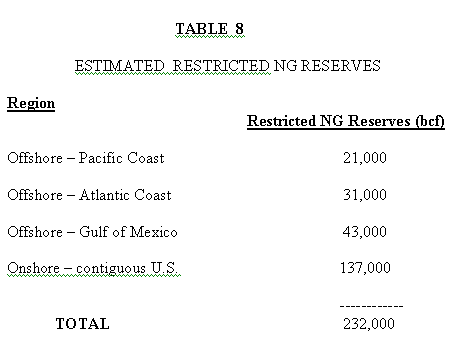
Despite the ready availability of these reserves, however, the
Nation refuses to initiate the development of this much needed
supply. As recently as May 19, the U.S. House defeated by voice
vote a proposal to open sections of the OCS to NG exploration and
development.
CAVEAT: DEUS EX MACHINA?
At this point most readers will be contemplating how (a) LNG
imports and (b) non-conventional NG production, e.g. coalbed
methane and deepwater drilling will alleviate this situation.
There is no question both of these sources have great promise –
but at this point the argument that they can both offset NG
production declines and meet incremental demand is more hypothesis
than proposition. Specifically, we are betting much of our energy
future on untested assumptions. Recent comments from the energy
industry highlight the problems with U.S. production : (1) Lee
Raymond , CEO of Exxon, recently told reporters “Gas production
has peaked in North America’’ and (2) Energy Security Analysis,
Inc. noted the “ steep decline rates of aging fields in Texas,
Louisiana and Oklahoma” and the fact that “domestic production
will make up a significantly diminished share of U.S. supply”.
In terms of LNG, for example, Andrew Weismann (2005a, 2005b),
has raised serious questions regarding LNG (a) availability, (b)
price and (c) impact upon both our national and fiscal security.
In regard to non-conventional sources, one should recognize that
depletion, lack of equipment and environmental regulations impact
these sources as well. Overall, the expectation that relatively
untested (on a massive scale) sources of NG will offset the issues
mentioned here is a high stake gamble. Like the Greek tragedies of
old, salvation may arrive from out of the blue but submitting our
energy future to a complex and fragile series of unverified
assumptions is risky indeed.
MAJOR REFERENCES
Dietert, Jeff; Kessler, R and Morris, M. “Outlook for Natural
Gas”, Simmons and Company International, 2005.
Energy Information Agency – various reports, forecasts and
analyses at www.eia.doe.gov
Land Rig Newsletter, various issues, 2005.
Riva, Joseph, U.S. Conventional Wisdom and Natural Gas,
Colorado School of Mines, July, 1997.
Weissman, Andrew, “The Critical Need to Examine More Carefully
the role of Liquefied Natural Gas…” Energy Pulse, (2005a).
Weissman, Andrew, “The LNG Challenge”, Testimony presented
before California Public Utility Commission, (2005b).
To join in on the conversation or to subscribe or visit
this site go to: http://www.energypulse.net
Copyright 2005 CyberTech, Inc.
|

